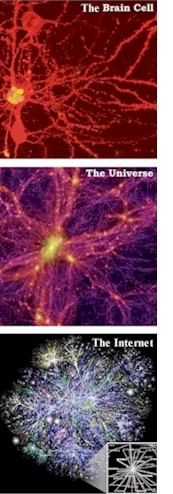 I was thrilled to stumble upon this video (below) from NOVA, today, on patterns. As I watched it, I kept hoping that it would end the way it in fact did, because I watched a film at our University of Colorado Fiske Planetarium a few months ago where the astrophysics student-narrator zoomed out as far as possible to look at the cosmos, and showed us how it resembled our very own brain neurons.
I was thrilled to stumble upon this video (below) from NOVA, today, on patterns. As I watched it, I kept hoping that it would end the way it in fact did, because I watched a film at our University of Colorado Fiske Planetarium a few months ago where the astrophysics student-narrator zoomed out as far as possible to look at the cosmos, and showed us how it resembled our very own brain neurons.
This is an awesome conclusion that astrophysicists have come to. Who among us does not have a sense of wonder about the order of the universe – from the tiniest microscopic inhabitants to the largest? Astrophysicists also tell us to marvel at the fact that we are made up of atoms from the distant past universe events, thus we are part of it, or it is part of us. Either way you look at it is correct. That fact also makes it true that we are all connected to everything else, a fundamental piece of knowledge from centuries old Eastern wisdom traditions.
There are patterns obvious in the natural world that help teach us that there is an incredible order to the universe. Artists like to refer to observations such as we can easily see in a cross section of the Nautilus Shell as “sacred geometry”. Geometric ratios can further be found in harmonic music. It is our senses that allow us to appreciate these natural patterns and the experience of “beauty”.
From reading quotes by Einstein, it appears that he had a fascination and also a great respect (if not a recognition that it was his life’s purpose) for observing and attempting to understand the incredible order of the universe. In part, this was attempted through the use of mathematical equations, though he also appeared to think that the human brain was inadequate to completely understand the governing laws of nature.
Let us review a few quotes from Einstein and consider “spooky” quantum physics events and yet a more intriguing picture emerges.
Quotes by Albert Einstein:
“A human being is a part of the whole, called by us “Universe”, a part limited in time and space.”
“Now he has departed from this strange world a little ahead of me. That means nothing. People like us, who believe in physics, know that the distinction between past, present, and future is only a stubbornly persistent illusion.”
“I am a determinist. As such, I do not believe in free will.” -— from Einstein: His Life and Universe, by Walter Isaacson.
“It is enough for me to contemplate the mystery of conscious life perpetuating itself through all eternity, to reflect upon the marvelous structure of the universe which we dimly perceive, and to try humbly to comprehend an infinitesimal part of the intelligence manifested in nature.” —- from Introduction to Philosophy 1935.
The following two quotes attributed to Einstein are from “Einstein and the Poet”:
“The basic laws of the universe are simple, but because our senses are limited, we can’t grasp them. There is a pattern in creation.”
“I like to experience the universe as one harmonious whole. Every cell has life. Matter, too, has life; it is energy solidified.”
Finally, let’s take time to watch the (3-minute) aforementioned NOVA video showing us that patterns structure the Universe:
So none among us can dispute that neural network forms are a basic building block pattern. But could consciousness itself be the larger whole? Watch this TED talk (below) and contemplate that idea. It explores the idea of consciousness being a fundamental building block of the universe, the idea of “panpsychism”, in this talk by David Chalmers. (18 minutes – if you don’t have time to watch the whole thing, at least try to watch the last half):
If these things are all relevant in the “big picture” then we view nature with awe and do not wish to see it destroyed. We see our role as an interconnected part having compassion for the whole. And that, my friends, is how this post ties into the subject of agriculture.

